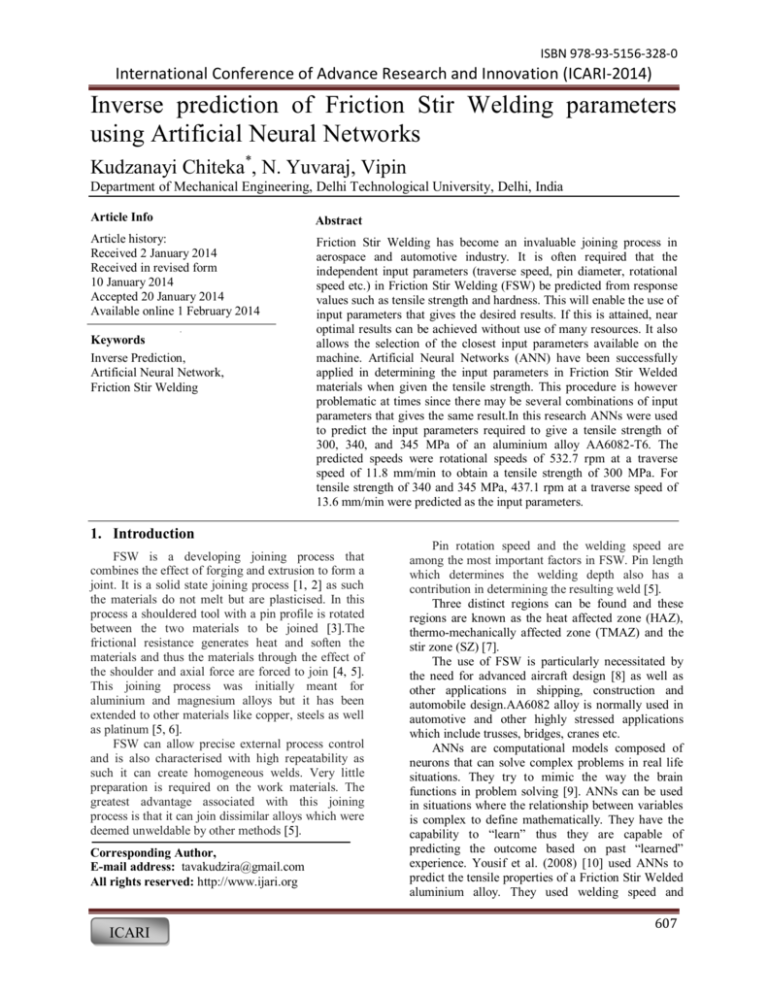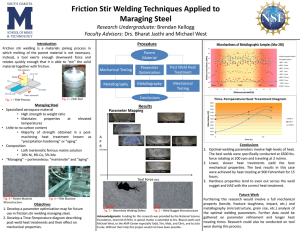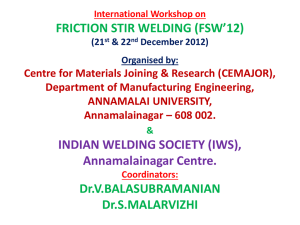
ISBN 978-93-5156-328-0
International Conference of Advance Research and Innovation (ICARI-2014)
Inverse prediction of Friction Stir Welding parameters
using Artificial Neural Networks
Kudzanayi Chiteka*, N. Yuvaraj, Vipin
Department of Mechanical Engineering, Delhi Technological University, Delhi, India
Article Info
Abstract
Article history:
Received 2 January 2014
Received in revised form
10 January 2014
Accepted 20 January 2014
Available online 1 February 2014
Friction Stir Welding has become an invaluable joining process in
aerospace and automotive industry. It is often required that the
independent input parameters (traverse speed, pin diameter, rotational
speed etc.) in Friction Stir Welding (FSW) be predicted from response
values such as tensile strength and hardness. This will enable the use of
input parameters that gives the desired results. If this is attained, near
optimal results can be achieved without use of many resources. It also
allows the selection of the closest input parameters available on the
machine. Artificial Neural Networks (ANN) have been successfully
applied in determining the input parameters in Friction Stir Welded
materials when given the tensile strength. This procedure is however
problematic at times since there may be several combinations of input
parameters that gives the same result.In this research ANNs were used
to predict the input parameters required to give a tensile strength of
300, 340, and 345 MPa of an aluminium alloy AA6082-T6. The
predicted speeds were rotational speeds of 532.7 rpm at a traverse
speed of 11.8 mm/min to obtain a tensile strength of 300 MPa. For
tensile strength of 340 and 345 MPa, 437.1 rpm at a traverse speed of
13.6 mm/min were predicted as the input parameters.
Keywords
Inverse Prediction,
Artificial Neural Network,
Friction Stir Welding
1. Introduction
FSW is a developing joining process that
combines the effect of forging and extrusion to form a
joint. It is a solid state joining process [1, 2] as such
the materials do not melt but are plasticised. In this
process a shouldered tool with a pin profile is rotated
between the two materials to be joined [3].The
frictional resistance generates heat and soften the
materials and thus the materials through the effect of
the shoulder and axial force are forced to join [4, 5].
This joining process was initially meant for
aluminium and magnesium alloys but it has been
extended to other materials like copper, steels as well
as platinum [5, 6].
FSW can allow precise external process control
and is also characterised with high repeatability as
such it can create homogeneous welds. Very little
preparation is required on the work materials. The
greatest advantage associated with this joining
process is that it can join dissimilar alloys which were
deemed unweldable by other methods [5].
Corresponding Author,
E-mail address: tavakudzira@gmail.com
All rights reserved: http://www.ijari.org
ICARI
Pin rotation speed and the welding speed are
among the most important factors in FSW. Pin length
which determines the welding depth also has a
contribution in determining the resulting weld [5].
Three distinct regions can be found and these
regions are known as the heat affected zone (HAZ),
thermo-mechanically affected zone (TMAZ) and the
stir zone (SZ) [7].
The use of FSW is particularly necessitated by
the need for advanced aircraft design [8] as well as
other applications in shipping, construction and
automobile design.AA6082 alloy is normally used in
automotive and other highly stressed applications
which include trusses, bridges, cranes etc.
ANNs are computational models composed of
neurons that can solve complex problems in real life
situations. They try to mimic the way the brain
functions in problem solving [9]. ANNs can be used
in situations where the relationship between variables
is complex to define mathematically. They have the
capability to “learn” thus they are capable of
predicting the outcome based on past “learned”
experience. Yousif et al. (2008) [10] used ANNs to
predict the tensile properties of a Friction Stir Welded
aluminium alloy. They used welding speed and
607
ISBN 978-93-5156-328-0
International Conference of Advance Research and Innovation (ICARI-2014)
rotational speed as the input into the ANN and
successfully predicted the tensile behaviour and
hardness with high accuracy. In their research,
Levenberg – Marquardt algorithm which showed
better performance than gradient descent was used for
training.
Okuyucu et al. (2007) [11] also used ANN to
predict the tensile strength of aluminium alloys joined
by FSW and got convincing results.Welding speed as
well as rotational speed were also used as the input
parameters into the network. Back-propagation
algorithm was used. This algorithm was improved by
making use of the scaled conjugate gradient and
Levenberg-Marquardt algorithms.
Nagesh and Datta (2002) [12] used ANNs to
predict weld bead geometry and penetration in
shielded metal arc welding. Back-propagation neural
networks were used to associate the welding process
variables with the features of the bead geometry and
penetration. Their results from the experiments
carried out showed a small errorpercentage difference
between the estimated and experimental values.
taken. The results were averaged for each particular
set of input parameters i.e. for each combination of
rpm and welding speed.
2. Experimental Procedure
A feed-forward back propagation ANN
architecture with two layers was made. It had one
input, one hidden layer with ten neurons and two
outputs. The input was the tensile strength and the
outputs were the rotational speed (Rs) and Traverse
speed (Ts). The training algorithm used was
Levenberg-Marquardt.
2.1 Welding and Testing Procedure
Aluminium alloy AA6082-T6 with a tensile
strength of 340MPa was used in the experimentation.
Its dimensions were 150 x 100 x 6 mm. Welding was
carried out on a vertical milling machine using
rotational speeds of 630, 1000 and 1600 rpm and
welding speeds of 10, 16 and 25 mm/min. These
speeds were chosen based on availability on the
milling machine used.A total of nine (3 x 3)
experiments were done. The chemical composition of
AA6082-T6 is as shown in table 1.
Fig: 1. Tensile test sample
The tensile properties of the FSWed specimens
were examined using computer controlled universal
testing machine (Tinius Olsen H50KS) at a constant
cross head speed of 1mm/min in room temperature.
The tensile specimens prepared on the middle of the
FSW stir
zone
by
wire
EDM
as
per ASTMstandard. Fig.1shows the
size
and
configuration of the tensile specimen
2.2 ANN procedure
Table: 1. Chemical composition of AA6082
Element
Si
Fe
Cu
Mn
Mg
Zn
Ti
Al
%
Present
0.7-1.3
0.0-0.5
0.0-0.1
0.4-1.0
0.6-1.2
0.0-0.2
0.0-0.1
Remaining
Tool material used was H13. The tool had the
following dimensions; 18mm shoulder diameter, 6mm
pin diameter, 5.8mm pin length and a left hand thread
of 1mm pitch. For tensile tests, samples were cut
using Wire Electric Discharge Machining (WEDM) in
a direction perpendicular to the welding direction.
For each work sample, three tensile test samples were
ICARI
Fig: 2. ANN architecture in inverse prediction
The results taken from the experimentation were
fed into the neural network for training. There was no
testing of the ANN using known data because the
concept of inverse prediction is a bit complex in
nature. There are several input combinations that can
give rise to the same output. The predicted output,
however, could still be validated through
experimentation.
3. Results and Discussion
608
ISBN 978-93-5156-328-0
International Conference of Advance Research and Innovation (ICARI-2014)
Experiments were done according to the values
Table: 2. Input parameters and the resulting Tensile
given in table2. Tensile strength (σt) decreased
strength
significantly with increase in rotational speeds.
Rs(rpm)
Ts(mm/min) σt (MPa)
Three desired tensile strength (σreq) values were
1
630
10
296.96
established arbitrarily for prediction of the input
2
16
260.25
values. They were put into the ANN and the predicted
3
25
255.34
values were obtained. These values were not readily
4
1000
10
257.51
available on the milling machine used so the nearest
5
16
190.00
available values were selected as shown in table4with
6
25
211.88
available rotational speed and traverse speed denoted
7 1600
10
195.55
by Rs(Av) and Ts(Av) respectively. The available values
8
16
140.56
from which the selection was made are given in
9
25
129.89
table3.These were the speed values present on the
milling machine gear box available for selection.
Table: 3. Speeds available on the machine
Rs (rpm)
Ts
25
10
40
16
63
25
100
40
160
63
250
100
400
160
630
250
1000
400
1600
630
(mm/min)
Table: 4. Predicted and available speeds
σreq
Rs(ANN)
Ts(ANN)
Rs(Av) Ts(Av)
1 300 532.7507 11.8268 630
10
2 340 437.1815 13.6182 400
16
3 345 437.1348 13.6191 400
16
σreq- Required tensile strength, Rs(ANN) - rpm predicted
by ANN, Ts(ANN)- welding speed predicted by ANN,
Rs(Av)-available rpm on the machine, Ts(Av)-available
welding speed on the milling machine.
The selected input parameters were used to join
two work samples and the results were astonishingly
convincing. There was some difference but this could
easily be attributed to the difference in predicted
values and the actual values used in the experiments.
Table: 3. Experimental Testing of predicted values
1
2
σreq
350
372
375
σexp
331.23
340.31
Rs(Av)
630
400
Ts(Av)
10
16
References
[1] M. M. Z Ahmed, B. P Wynne, W. M Rainforth,
P. L Threadgill, Microstructure, crystallographic
texture and mechanical properties of friction stir
welded AA2017A,Materials Characterization, 64
(2012) 107-17.
[2] S Babu, G. D Janaki Ram, P. V Venkitakrishnan,
M. G Reddy, P. K Rao, Microstructure and
Mechanical Properties of Friction Stir Lap
Welded Aluminium Alloy AA2014, J. Mater. Sci.
Technol, 28(2012) 414-426
[3] A Kostika, R. S Coelho, J. dos Santos, A. R
Pyzalla, Microstructure of friction stir welding of
ICARI
σreq- required strength, σexp- strength obtained from
experiment.
4. Conclusion
ANNs can predict the independent FSW input
parameters given the desired response values and it is
possible to get the desired result as long the predicted
parameters are available on the machine. However,
since the ANNs can predict any values, there is need
to integrate the machine characteristics so as to
develop a method that predicts values close to those
available on the machine. This is however not a
problem if advanced machines with infinite variable
gearboxes are used. If an effective and more accurate
method is developed, the number of experiments in
FSW to obtain desired tensile strength and even
hardness values could be reduced significantly.
If the parameters predicted can be made available
on the machine, tensile strengths close to or just
above the UTS of the material can be obtained.
aluminium alloy to magnesium alloy, Scripta
Materialia, 60 (2009) 95-956.
[4] T Sano, J Yu, J Medintz, C. F. Yen, K Doherty,
The effect of friction stir welding on the
microstructure and tensile properties of Al 2139T8 alloys, The Minerals, Metals & Materials
Society, (2012) 497-501.
[5] C Meran, The joint properties of brass plates by
friction stir welding,Materials and Design, 27
(2006) 719-726.
[6] Z. Barlas, H Uzun, Microstructure and
mechanical properties of friction stir butt welded
dissimilar Cu/CuZn30 sheets, Journal of
609
ISBN 978-93-5156-328-0
International Conference of Advance Research and Innovation (ICARI-2014)
Achievements in Materials and Manufacturing
Engineering, 30 (2008) 182-186.
[7] D Rao, K Huber, J Heerens, J. F dos Santos, N
Huber, Asymmetric mechanical properties and
tensile behaviour prediction of aluminium alloy
5083 friction stir welding joints, Materials
Science & Engineering, A 565 (2013) 44-50.
[8] I Shigematsu, Y. J Kwon, K Suzuki, T Imai, N
Saito, Joining of 5083 and 6061 aluminium alloys
by friction stir welding, Journal Of Materials
Science Letters, 22 (2003) 353-356.
[9] A. K. Lakshminarayanan, V. Balasubramaian,
Comparison of RSM with ANN in predicting
tensile strength of friction stir welded AA7039
ICARI
aluminium alloy joints, Trans. Nonferrous Met.
Soc. China, 19(2009) 9-18.
[10] Y. K Yousif, K. M. Daws, B. I Kazem, Prediction
of Friction Stir Welding Characteristic Using
Neural Network, Jordan Journal of Mechanical
and Industrial Engineering, 2 (2008) 151-155.
[11] H Okuyucu, A. Kurt, E Arcaklioglu, Artificial
neural network application to the friction stir
welding of aluminium plates, Materials and
Design, 28 (2007) 78-84.
[12] D. S. Nagesh, G. L Datta, Prediction of weld
bead geometry and penetration in shielded metalarc welding using artificial neural networks,
Journal of Materials Processing Technology, 123
(2002) 303-312
610









